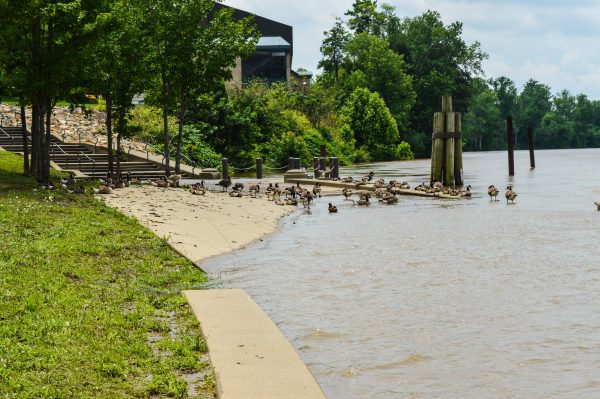It just doesn’t seem fair.
According to the Federal Emergency Management Agency, property owners on Wheeling Island and along Big Wheeling Creek risk the same as do those who own beachfront properties. The “AE Zone” is one of five FEMAs established when re-structuring the country’s flood plain maps a couple of years ago, and with the new classifications arrived a new pricing structure for flood insurance policies underwritten by the National Flood Insurance Program.
Many have noticed the 18 percent increases on residential properties the past two years, and owners of commercial and rental parcels have been hit with 25 percent increases.

“It is not fair,” said Bernie Glenn, owner of the Bernie Glenn Insurance Service in the Warwood section of Wheeling. “Of course, FEMA has said that they would work on establishing more zones because there really needs to be. But we haven’t seen anything about that either.
“If the private industry had it, we would see more zones established. Government has always been a ‘one-size-fit-all’ government, but that doesn’t work well when insurance comes into play,” he said. “That’s part of the problem around here because you have people who barely get touched by floods who are paying the same premiums as other people who get a lot of water, and they are paying the same kind of premiums that owners of beachfront properties are paying. How does that make sense to anyone?”
The flood insurance issue has concerned local residents and lawmakers since the Biggert-Waters Act received congressional approval and was signed into law in 2012. Slight changes were made in March 2014, when the Flood Insurance Affordability Act lowered the annual premium price increase on primary residential properties to 18 percent.
But for how many more years will these premiums increase? What is the long-term impact for nearly 25 percent of properties in Wheeling? If those parcels lose considerable worth because of the FEMA classifications and coinciding premium rates, how will that impact properties outside the “AE Zone”?
“Those are all questions that do not have answers right now because FEMA is offering no answers,” Glenn reported. “What we do know is that if the premiums keep going up for these properties, those properties will become far less attractive when put on sale. Anytime that happens for whatever reason, the ripple effects are not positive in any way.”
Can officials of the city of Wheeling make enough noise about this issue to make a difference with federal lawmakers?
“I think a large group of cities, if they joined together through some kind of organization, could make enough noise to make a difference, but I don’t know if an individual city could make enough noise,” said Wheeling City Manager Bob Herron. “But I do believe an individual city could initiate that kind of effort.”

One Frightful Flight.
Glenn found his seat on an airliner at the McCarren International Airport in Las Vegas and began preparing for his return flight to Pittsburgh. He has his routine, too.
“I was getting my reading material ready for the flight, and the first thing I had in my hands was an insurance industry trade magazine,” he said. “I noticed the guy sitting next to me was looking over a little bit at it. Then he asked me if I was an insurance agent, and I told him I was.
“He then told me he was an insurance agent, too, and he told me to put my magazine down because he had to tell me something that was coming down the pike,” he said. “He told me that he had just finished attending a FEMA Conference, and that they had enlightened the agents in attendance about something he said I just wasn’t going to believe.”
He didn’t look out of the window to see the clouds and the country below. Glenn just listened.
“He said that there are a lot of changes that would could into effect the coming September, and he spent that two-hour flight filling me in on what FEMA had planned for those who were paying mortgages on properties that were located in FEMA’s new flood plains across the country,” Glenn said. “I had heard that there may be some premium increases, but no one really knew anything for sure at that time, and FEMA wasn’t saying much at all. Well, they told this guy a whole lot.
“At first he told me that the premiums were going to go up as much as 900 percent, and at first I didn’t believe him because I had never seen any premium increase even close to that percentage,” he said. “He said that by his best measure he was guessing that everyone’s premiums would double, but he wasn’t very sure because of how vague the FEMA people were being at this conference. And quite frankly, to this day, FEMA is still being very vague about anything connected to this issue.”
By the end of the flight, Glenn wasn’t sure what to believe. It sounded outrageous even for the federal government.
“It was just shocking, and I thought he was exaggerating at the time to be honest with you. I thought we would get hit with a pretty good increase, but I was skeptical,” Glenn said. “As soon as I got back to work I started calling a lot of people who I thought would have more information than what I had, and I was shocked that I knew more than those people did.
“That’s when I got online, and I started reading about the Biggert-Waters Act, but it really wasn’t until the implementation actually took place when we all realized exactly what was taking place with our flood insurance premiums,” he continued. “It was very difficult to tell any of my clients much more than to warn them that this was coming, but all they wanted to know was the bottom line, and that was something I didn’t know.
“I had to guess, and I just kept telling them that I thought the premium could double on them over time, but that I really didn’t know because FEMA wasn’t sharing a lot of information,” he said. “Little did we know at that time that double would have been a better deal than what FEMA had planned.”
He went door to door knocking for residents residing in these “AE Zone” properties, and one after another he realized more that the increases were real, and the impact was looming on Wheeling Island, in Dimmeydale, South Wheeling, Elm Grove, Centre Wheeling, along Valley View Avenue, and in the downtown district.
But two years later, far too many questions remain.
“Right now we are in another one of those silent periods again with FEMA because they won’t make their intentions clear as far as where they intend to take this,” Glenn said. “They promised that studies would be conducted, and they promised that local meetings would take place, and they have done none of that. Plus, they set these caps as far as how much they could increase it, and that’s 25 percent on commercial and rental properties and 18 percent on primary residential properties, and so far in the two years that they could do it, they have raised it to the max.
“At 18 percent, that premium is going to double every four years, and at 25 percent that premium is going to double in a little less than three years, and no one seems to know how far they are going to take it,” he said. “Are they going to stop when those percentages reach 100 percent so the subsidies are completely gone? Or will they take it beyond 100 percent. No one knows the answer to that question.”

Private Market to the Rescue?
The NFIP was established by the federal government in 1968 because private insurance companies backed away from underwriting the policies after a rash of floods took place in the United States. In West Virginia, however, the re-establishment of a private market for flood insurance is legal now thanks to legislation sponsored by former state Sen. Rocky Fitzsimmons and passed by both houses of the West Virginia Legislature in 2014.
That private market, though, could be the answer, Herron said, because actual risk would be considered.
“I would think that the private market in certain areas of the country will step in eventually, but if you have one flood that is catastrophic on Wheeling Island and South Wheeling, there are going to be a lot of claims filed by policyholders. That equals a lot of dollars, and an insurer would have to sustain that.
“But part of it would have to involve the insurance agent that works for a private insurance company establishing your true risk so they can charge you what you deserve to be charged,” he said. “But there’s a lot about this program that just isn’t right and just not fair.”
Glenn, a resident of Wheeling Island, has been successful in utilizing a private company to underwrite flood insurance policies for property owners along the banks of the Ohio River and Big Wheeling Creek, but not by working with the West Virginia-based insurer.
“When I first started trying to work with private companies, I couldn’t get any of the property owners around here a policy, but then a desperate policyholder gave me a tip and asked me if I would look into it,” Glenn said. “I checked it out, and I found a pretty good alternative to the NFIP, and that was the Flood Insurance Agency out of the state of Florida.
“It’s a company that is underwritten by Lloyds of London, and their policies are very close to the cost of the old premiums, and it meets all of the requirements set forth by Biggert-Waters. It had to be the exact same policy as what is offered by the government, and that’s what the policy is,” he continued. “All of the local banks have accepted it, and our agency has already written as many as 80 of those policies.”
Whether or not the company will be successful will become known only after claims are filed.
“To be truthful, we’ll only know after the first flood,” Glenn said. “No one is anxious for a flood, but it’s only then when we will know if these private companies can be successful in covering the claims and staying in business.
“If you are required to have it, or if you want flood insurance, you can still purchase it from the government, but their intentions, in my opinion, are very vague. I do not know if these property owners will be looking at flood insurance premiums of as much as $7,000 per year for $100,000 worth of coverage,” he continued. “One of the only good things that came out of Biggert-Waters was that they established the criteria for private companies to get involved with selling those policies, and that meant the government would have some competition.”
Glenn said if property owners wish to obtain a quote via the Internet, they can do so by visiting: www.privatemarketflood.com. If property owners in West Virginia do know if their parcel is located within a flood plain, they may check on this website: http://www.mapwv.gov/flood/.
Ohio property owners can accomplish the same by visiting: https://msc.fema.gov/portal.

All Should Worry.
Since the passage of the Biggert-Water Act three years ago, confusion has been prevalent amongst property owners in and out of the new FEMA flood plain areas. In fact, the majority of property owners outside the flood plains have failed to understand how the ripple effects could affect the worth of their parcels.
“That’s an education process that the city officials could do a better job on,” Herron said. “And we need to do that because, over time, it will reduce the value of the impacted area, and then that causes a ripple effect to the non-flood plain areas because the burden to pay for services will be shifted.
“That’s the long-term problem that people in unaffected areas need to be aware of. This will impact them, too, if changes are not made,” he said. “That shift will take place and everyone needs to be aware of that.”
Glenn agreed with Wheeling’s city manager.
“As taxpayers we own the public buildings that government has constructed, and there are several of those that are in the flood plain in downtown Wheeling and elsewhere in the city,” he explained. “And with the possible loss of properties, the school system would be impacted because of the decrease in collected property taxes.
“Throughout the state there could be a loss of hundreds of thousands of dollars – if not millions of dollars – that flow to our schools that may no longer because of an overall decrease in property values, and when that is gone, those dollars have to be replaced, or cuts have to be made,” he said. “So in the end, I believe we’ll be paying higher taxes to make up the dollars, and the impacts could trickle down into a number of other places, too.”
Why? Supply and demand.
“I believe the obvious thing to see now is that people are not going to want to invest in properties that are in the flood zones because of the extra cost is involved, and that’s going to change some things because people have always wanted to live by the water, vacation near the water, and even eat near the water,” he said. “That’s just the way we are, but this is going to drive up the prices for those services, and we’re not going to see many new places opening in those areas.
“And it’s hard to imagine what some of our neighborhoods would look like. I’m sure there would be some people left because they own their properties outright and are not required to have the policies, but what happens when they go to sell those houses? That no one knows,” Glenn continued. “For the most part, the water is good for the economy, and I think the government is just getting in the way of themselves.
“It’s just so hard to guess what the end game looks like around here. As far as the insurance, the premium price should match the risk. For example, on Wheeling Island I would estimate that when it floods, 70 percent of those properties experience little to no damage whatsoever, but that’s not how the policies are sold,” he added. “But I do think the private market will come in and save this situation as long as those insurance companies have the assets to be able to cover that kind of disaster.”
(Photos by Steve Novotney)





